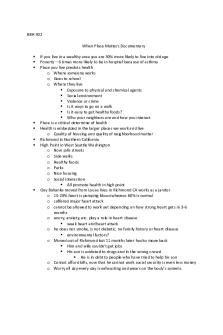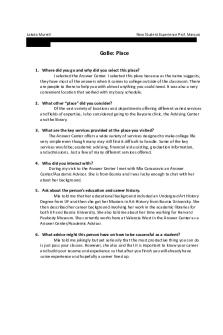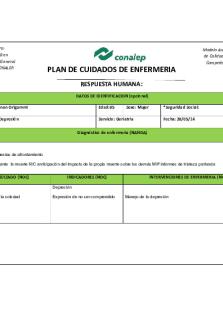When Place Matters - Grade: A+ PDF

| Title | When Place Matters - Grade: A+ |
|---|---|
| Course | Diversity And Health Xlist Aaa S 302 |
| Institution | The Pennsylvania State University |
| Pages | 4 |
| File Size | 55.7 KB |
| File Type | |
| Total Downloads | 25 |
| Total Views | 171 |
Summary
Download When Place Matters - Grade: A+ PDF
Description
BBH 302 When Place Matters Documentary
If you live in a wealthy area you are 30% more likely to live into old age Poverty – 6 times more likely to be in hospital because of asthma Place you live predicts health o Where someone works o Goes to school o Where they live Exposure to physical and chemical agents Social environment Violence or crime Is it ways to go on a walk Is it easy to get healthy foods? Who your neighbors are and how you interact Place is a critical determine of health Health is embedded in the larger places we work and live o Quality of housing and quality of neighborhood matter Richmond in Northern California High Point in West Seattle Washington o Now safe streets o Side walks o Healthy foods o Parks o Nice housing o Social interaction All promote health in high point Guy Bukanka moved from Louse lives in Richmond CA works as a janitor o 15-20% heart is pumping blood whereas 60% is normal o suffered major heart attack o cannot be allowed to work yet depending on how strong heart gets in 3-6 months o worry, anxiety, etc. play a role in heart disease weak heart and heart attack o he does not smoke, is not diabetic, no family history or heart disease environmental factors? o Moved out of Richmond but 11 months later had to move back Him and wife couldn’t get jobs His son is addicted to drugs and in the wrong crowd He is in debt to people who have tried to help his son o Cannot afford bills, now that he cannot work social security is even less money o Worry all day every day is exhausting and wears on the body’s systems
Chronic stress leads to cortisol and adrenaline being released too much Leads to arterial plaque, weakened immune system, and raise blood pressure which increases risk for every chronic disease including heart disease o Heart disease is leading killer in America o Daughter was shot and killed Just opening the door She was successful student who was mistaken target of a drug gang Richmond, California o Chemical companies release tons of toxins each year in Richmond o Fresh produce, quality housing is hard to find o Liquor, tobacco, and drugs are easy to find o Higher rates of asthma, diabetes, low life expectancy, and hospitalization o High rates of low birth weight, hypertension, and obesity overlap with poverty and environmental hazards on the map of the town Cluster in Richmond o Higher rates of death from cancer and heart disease than other areas o Children hospitalized for asthma at twice the rate o Risk of dying from diabetes is twice as high o Improving health changing behaviors NO, because it is limited by where you live o Teens with gallbladders removed because of high rates of fatty food consumption Fast food is very cheap and very prevalent Short term barging- 2000 calories for 3 dollars o 50% of people use more than 30% of their income on housing costs o buying a car in a low income costs 500 dollars more than in rich areas o cashing a check is 10% more o furniture, appliances, and groceries are more expensive this is called the poverty tax o patients come in very sick, patch them up, save their lives and send them back ot same environment Why are these neighborhoods different? o It is not natural o Policies and absence of policies that create inequalities in where people live o 60 years ago Richmond was a boom town o Kaiser shipyards in Richmond ran 24 hours a day Every ethnicity was in Richmond working After war II ended the government put into place new policies Thousands of jobs were lost Ship yards closed Everyone else Richmond Rich white families that could get approved for government backed mortgages in the suburbs Richmond’s population dropped by a 1/3
o Public investments in building suburbs FHA loans Loans where the government gave people discounts to build up the suburbs Government gave loans to primarily white families in the suburbs Until 1960s there were racial basis for these loans African Americans did not have access Until 1962 out of the loans (120 billion dollars) less than 2% went to non white households 350,000 new home loans less than 100 went to black families in California after the war in cites blacks were let in the cities that were neglected o in the 1980s Latinos and Asians moved into the cities too One the neighborhood goes downhill the bank does not want to come and invest money the less money the less good schools, the less good schools, the less people coming into the city 50-80% increase risk in heart disease if living in a poor neighborhood Everyone experiences stress o But in poor areas there is multiple constant stress and very few resources to cope with the stress Vietnamese and Cambodians are lumped together as Asian Americans which is harmful o immigrants address health problems by creating community agencies exposure to violence o Richmond had one of highest murder rates in 2005 o Lessens life expectancy o Lessens ability to go outdoors o Lessens ability to do things Exposure to violence triggers physiological responses in a child that lead to the adult begin primed to be more susceptible to mental and physical health problems Kids in Richmond thing they won’t live past 20 o YES youth empowerment strategies Gives youth sense of hope by showing at early age by their actions they can work together to create positive change in the community Hope impacts health because you don't internalize negative things o You realize you have a say in things that happen o Feeling you have control over what happens Highpoint Seattle Washington o In 1960s began as temporary housing for defense workers Was very poor and unsafe o By 1990s the housing had deteriorated Told neighborhood they would only be here a few years but they are still here o There used to be bullets flying at any given time o Unsafe outside
o Unhealthy inside o Asthma was endemic in this town Old units had leaking windows that leads to wet plaster board and formation of mold Moisture causes mold and dust mites And roaches All common triggers of asthma o 1 out of 9 or 1 out of 10 households had asthma o even through the danger there was a sense of community who wanted a healthy living condition that wealthy areas take for granite o community won Seattle Housing Authority grants to renovate highpoint not used to having power, did not know they even could have power o Highpoint is now integrated with mix incomes and a focus on health New clinic, new library, community center that has child care, employment services etc., community gardens where neighbors can sell organic produce to other neighbors o Nationwide 20 billion dollars every year go to asthma Low income neighborhoods are the most affected 3000-5000 dollars each year for each child for ER treatments o Focus of neighborhood is asthma focus Special features in home: ventilation system that brings in air from outside, particulates like mold and pollen are filtered out Air inside home is safer than air outside Breathe easy homes cost 6000 extra to build o Less than 2 years of healthcare costs in the ER o Hope 6 program that builds these homes is being phased out No one wants to build healthy homes for low income areas Must come from policy makers o Not everyone benefits… Some people who are displaced did not come back Who makes the choices for the neighborhoods? o Acknowledge where you live impacts your health Social environment, economic environment, physical environment together determine if you will be healthy Anti-violence is health policy, neighborhood improvement is health policy, education is health policy, anti-violence is health policy everything that improves someone’s quality of life has an impact on their health and is a health policy...
Similar Free PDFs

When Place Matters - Grade: A+
- 4 Pages

Place Matters Activity
- 2 Pages

Babcock Place - Grade: A
- 1 Pages

Go Be (Place) - Grade: A
- 2 Pages

Question 1 -When a
- 7 Pages

A Small Place
- 10 Pages

A Small Place - Kincaid summary
- 5 Pages

When Kids Get LIfe - A
- 5 Pages

When may i shoot - Grade: B
- 4 Pages

1.7 Description of a Place
- 1 Pages

15 When Brothers Share a Wife
- 3 Pages

Education Matters Scholarship
- 1 Pages

Distance Still Matters
- 10 Pages

Race Matters Cornel West
- 5 Pages

The South is a Place to Stay
- 8 Pages

Depresion - PLACE
- 3 Pages
Popular Institutions
- Tinajero National High School - Annex
- Politeknik Caltex Riau
- Yokohama City University
- SGT University
- University of Al-Qadisiyah
- Divine Word College of Vigan
- Techniek College Rotterdam
- Universidade de Santiago
- Universiti Teknologi MARA Cawangan Johor Kampus Pasir Gudang
- Poltekkes Kemenkes Yogyakarta
- Baguio City National High School
- Colegio san marcos
- preparatoria uno
- Centro de Bachillerato Tecnológico Industrial y de Servicios No. 107
- Dalian Maritime University
- Quang Trung Secondary School
- Colegio Tecnológico en Informática
- Corporación Regional de Educación Superior
- Grupo CEDVA
- Dar Al Uloom University
- Centro de Estudios Preuniversitarios de la Universidad Nacional de Ingeniería
- 上智大学
- Aakash International School, Nuna Majara
- San Felipe Neri Catholic School
- Kang Chiao International School - New Taipei City
- Misamis Occidental National High School
- Institución Educativa Escuela Normal Juan Ladrilleros
- Kolehiyo ng Pantukan
- Batanes State College
- Instituto Continental
- Sekolah Menengah Kejuruan Kesehatan Kaltara (Tarakan)
- Colegio de La Inmaculada Concepcion - Cebu